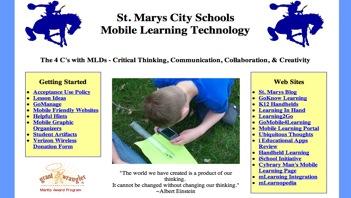Full Transparency
Our editorial transparency tool uses blockchain technology to permanently log all changes made to official releases after publication. However, this post is not an official release and therefore not tracked. Visit our learn more for more information.
This is a guest post by Scott Newcomb, an educator from Ohio who advocates for mobile learning.
Defining Mobile Learning
In education, the words "mobile learning" are starting to appear more often. Mobile learning is anytime, anywhere seamless learning. In other words, it is ubiquitous learning. A mobile learning device could be a net book, iPad, iPod Touch or even a smartphone.
A Change in Thinking
Many schools have labeled the use of mobile technology as a distraction in the classroom. Also, many schools have banned cell phones. On the other hand, as technology has improved, many schools are seeing the benefits of using cell phones in the classroom. Educators are coming to realize that the students use these types of devices every day at home, and then are asked to "power down" when they get to school.
Embracing Mobile Technology
St. Marys City Schools in Ohio has decided to embrace using Verizon Wireless smartphones as an educational tool for mobile learning. At St. Marys, the smartphones are referred to as a "Mobile Learning Device" (MLD). The term MLD is used because of the negative connotation of saying "cell phones in schools." The texting and the phone capabilities are turned off, which essentially makes it a small computer.This coming year, every student from 3rd to 5th grade will have a mobile learning device in his or her hand. There will be more than 500 devices within the school district. Also, the district will incorporate BYOD, Bring Your Own Device, as a pilot for the upper grade levels. The goal of the district is to have a mobile device in the hand of every student from 3rd to 12th grade. SMCS is leveling the playing field. Now, every student has Internet access, word processing capabilities and many supportive applications. The GoKnow applications that are being used allow the teachers to create and sync lessons to the students' devices. When students complete the assignment, they simply sync their work, and the teacher can grade their assignment at their computer. These Mobile Learning Devices are not an add-on within the classroom. The students are able to take them from class to class throughout the entire day. The students also have the ability to use video, audio and camera aspects on their device. Many teachers allow the students to bring their MLD on field trips to take pictures and to record notes.
This so-called "disruptive technology" has had a positive impact on the students. Unmotivated students have become motivated. The use of these devices has enabled educators to reach all learning styles. The students are completely immersed and engaged in their learning. St. Marys has noticed an increase in mathematics and writing achievement. With the ongoing improvements and changes being made technologically, St. Marys City Schools is making an effort to change along with the times. St. Marys has had great success implementing Mobile Learning devices into the classroom! To find out more about St. Marys Mobile Learning Technology, visit http://www.smriders.net/Mobile_Learning/. What are your thoughts on mobile learning? Do your children's schools use mobile devices for learning?

Scott Newcomb has taught for 11 years and works with 4th graders at St. Marys Intermediate School in Ohio, a public school in its fourth year using mobile learning devices with students. Scott helped organize and participated in the first Mobile Learning Technology Conference in Ohio in May of 2009. Scott has helped with professional development training for staff members using smartphone computers. He has presented about Mobile Learning at the E-Tech Ohio Conference, Mobile Learning Technology Conference in Ohio 2009-2010, OSBA Conference and the ISTE Conference in Denver, CO. Scott has also conducted webinars on the topic of mobile learning for Classroom 2.0 Live, EdTech Talk and the Reform Symposium.
Scott blogs about resources for mobile learning at themobilenative.org.
